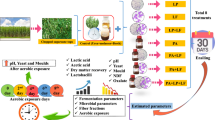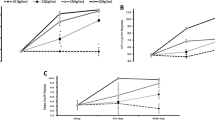Abstract
The study was conducted to evaluate the microbiological and chemical profiles of elephant grass inoculated with and without different wild strains of lactic acid bacteria. Silage was prepared of four treatments and one control with three replicates as control (EKC, adding 2 ml/kg sterilizing water), Lactobacillus plantarum (USA commercial bacteria) (EKP), Lactobacillus plantarum (EKA), Pediococcus acidilactici (EKB), and Pediococcus acidilactici (SKD) isolated from King grass. Silage were prepared using polyethylene terephthalate bottles, and incubated at room temperature for different ensiling days. The pH and acetic acid (AA) were significantly (P < 0.05) reduced and lactic acid (LA), butyric acid (BA), and ethanol were significantly increased (P < 0.05) at 3, 5, 7, and 14 days in treatment groups as compared to control. Water-soluble carbohydrate (WSC) and NH3–N concentration was not affected at days 3, 5, and 7, but significantly (P < 0.05) reduced at 14 days in treatment groups as compared to control. The LA, BA, and ethanol were significantly (P < 0.05) increased and AA, WSC NH3–N, and yeast were significantly (P < 0.05) decreased at 30 days of ensiling in treatment groups as compared to control. It is recommended that the inoculation of LAB could improve the fermentation quality of elephant grass silage and further effort is needed to evaluate these effects on silage produced on farm scale and on animal production performance.
















Similar content being viewed by others
References
Aksu T, Baytok E, Bolat D (2004) Effects of a bacterial silage inoculant on corn silage fermentation and nutrient digestibility. Small Rumin Rese 55:249–252
Amanullah S, Kim D, Lee H, Joo Y, Kim S, Kim S (2014) Effects of microbial additives on chemical composition and fermentation characteristics of barley silage. Asian Australas J Animal Sci 27:511
Arthur Thomas T (1977) An automated procedure for the determination of soluble carbohydrates in herbage. J Sci Food Agric 28:639–642
Barker SB, Summerson WH (1941) The colorimetric determination of lactic acid in biological material. J Biol Chem 138:535–554
Chaney AL, Marbach EP (1962) Modified reagents for determination of urea and ammonia. Clin Chem 8:130–132
Charmley E, Nelson D, Zvomuya F (2006) Nutrient cycling in the vegetable processing industry: utilization of potato by-products. Can J Soil Sci 86:621–629
Desta ST, Yuan X, Li J, Shao T (2016) Ensiling characteristics, structural and nonstructural carbohydrate composition and enzymatic digestibility of Napier grass ensiled with additives. Bioresour Technol 221:447–454
Driehuis F, Oude Elferink S, Van Wikselaar P (2001) Fermentation characteristics and aerobic stability of grass silage inoculated with Lactobacillus buchneri, with or without homofermentative lactic acid bacteria. Grass Forage Sci 56:330–343
Duncan DB (1955) Multiple range and multiple F tests. Biometrics 11:1–42
Filya I, Muck R, Contreras-Govea F (2007) Inoculant effects on alfalfa silage: fermentation products and nutritive value. J Dairy Sci 90:5108–5114
Gulfam A, Guo G, Tajebe S, Chen L, Liu Q, Yuan X, Bai Y, Saho T (2016) Characteristics of lactic acid bacteria isolates and their effect on the fermentation quality of Napier grass silage at three high temperatures. J Sci Food Agric 97:1931–1938
Guo G, Yuan X, Li L, Wen A, Shao T (2014) Effects of fibrolytic enzymes, molasses and lactic acid bacteria on fermentation quality of mixed silage of corn and hulless–barely straw in the Tibetan Plateau. Grassland Sci 60:240–246
International A (2005) Official methods of analysis of AOAC International. AOAC International 5:1269–1278
Keles G, O’Kiely P, Lenehan JJ, Forristal PD (2009) Conservation characteristics of baled grass silages differing in duration of wilting, bale density and number of layers of plastic stretch-film. Irish J Agric Food Res 1:21–34
Kim DH, Amanullah SM, Lee HJ, Joo YH, Kim SC (2015) Effect of microbial and chemical combo additives on nutritive value and fermentation characteristic of whole crop barley silage. Asian Australas J Animal Sci 28:1274
Liu Q, Chen M, Zhang J, Shi S, Cai Y (2012) Characteristics of isolated lactic acid bacteria and their effectiveness to improve stylo (Stylosanthes guianensis Sw.) silage quality at various temperatures. Anim Sci J 83:128–135
Meeske R, Van der Merwe G, Greyling J, Cruywagen C (2002) The effect of adding an enzyme containing lactic acid bacterial inoculant to big round bale oat silage on intake, milk production and milk composition of Jersey cows. Anim Feed Sci Technol 97:159–167
Ni K, Wang Y, Pang H, Cai Y (2014) Effect of cellulase and lactic acid bacteria on fermentation quality and chemical composition of wheat straw silage. Am J Plant Sci 5:1877
Nkosi B, Meeske R, Van der Merwe H, Groenewald I (2010) Effects of homofermentative and heterofermentative bacterial silage inoculants on potato hash silage fermentation and digestibility in rams. Anim Feed Sci Technol 157:195–200
Owens V, Albrecht K, Muck R (2002) Protein degradation and fermentation characteristics of unwilted red clover and alfalfa silage harvested at various times during the day. Grass Forage Sci 57:329–341
Pholsen S, Khota W, Pang H, Higgs D, Cai Y (2016) Characterization and application of lactic acid bacteria for tropical silage preparation. Anim Sci J 87:1202–1211
Santoso B, Hariadia BT, Manik H, Abubakar H (2011) Silage quality of king grass (Pennisetum purpureophoides) treated with epiphytic lactic acid bacteria and tannin of acacia. Media Peternak 34:140
Shah. YX, Zhihao D, Siran W, Tao S (2017) Effects of lactic acid bacteria on ensiling characteristics, chemical composition and aerobic stability of king grass. J Animal Plant Sciences 3:747–755
Van Soest PJ, Robertson JB, Lewis BA (1991) Methods for dietary fiber, neutral detergent fiber, and nonstarch polysaccharides in relation to animal nutrition. J Dairy Sci 74:3583–3597
Wilkinson J (2005) Silage. Chapter 19: Analysis and clinical assessment of silage. Chalcombe Publications, Southampton
Wrobel B, Zielinska A, Suterska A (2008) Evaluation of quality and aerobic stability of grass silage treated with bacterial inoculants containing Lactobacillus buchneri. In: Proceedings, 13th international conference on forage conservation, Nitra, Slovak Republic, pp 122–123
Zhang L, Yu C, Shimojo M, Shao T (2011) Effect of different rates of ethanol additive on fermentation quality of Napiergrass (Pennisetum purpureum). Asian Australas J Animal Sci 24:636–642
Acknowledgements
This work were supported by 31672488, 2016YFC0502005 and 2016ZDKJZC.
Author information
Authors and Affiliations
Corresponding author
Ethics declarations
Conflict of interest
The authors confirm that there is no conflict of interests.
Additional information
Communicated by Erko Stackebrandt.
Rights and permissions
About this article
Cite this article
Shah, A.A., Xianjun, Y., Zhihao, D. et al. Microbiological and chemical profiles of elephant grass inoculated with and without Lactobacillus plantarum and Pediococcus acidilactici . Arch Microbiol 200, 311–328 (2018). https://doi.org/10.1007/s00203-017-1447-1
Received:
Revised:
Accepted:
Published:
Issue Date:
DOI: https://doi.org/10.1007/s00203-017-1447-1




